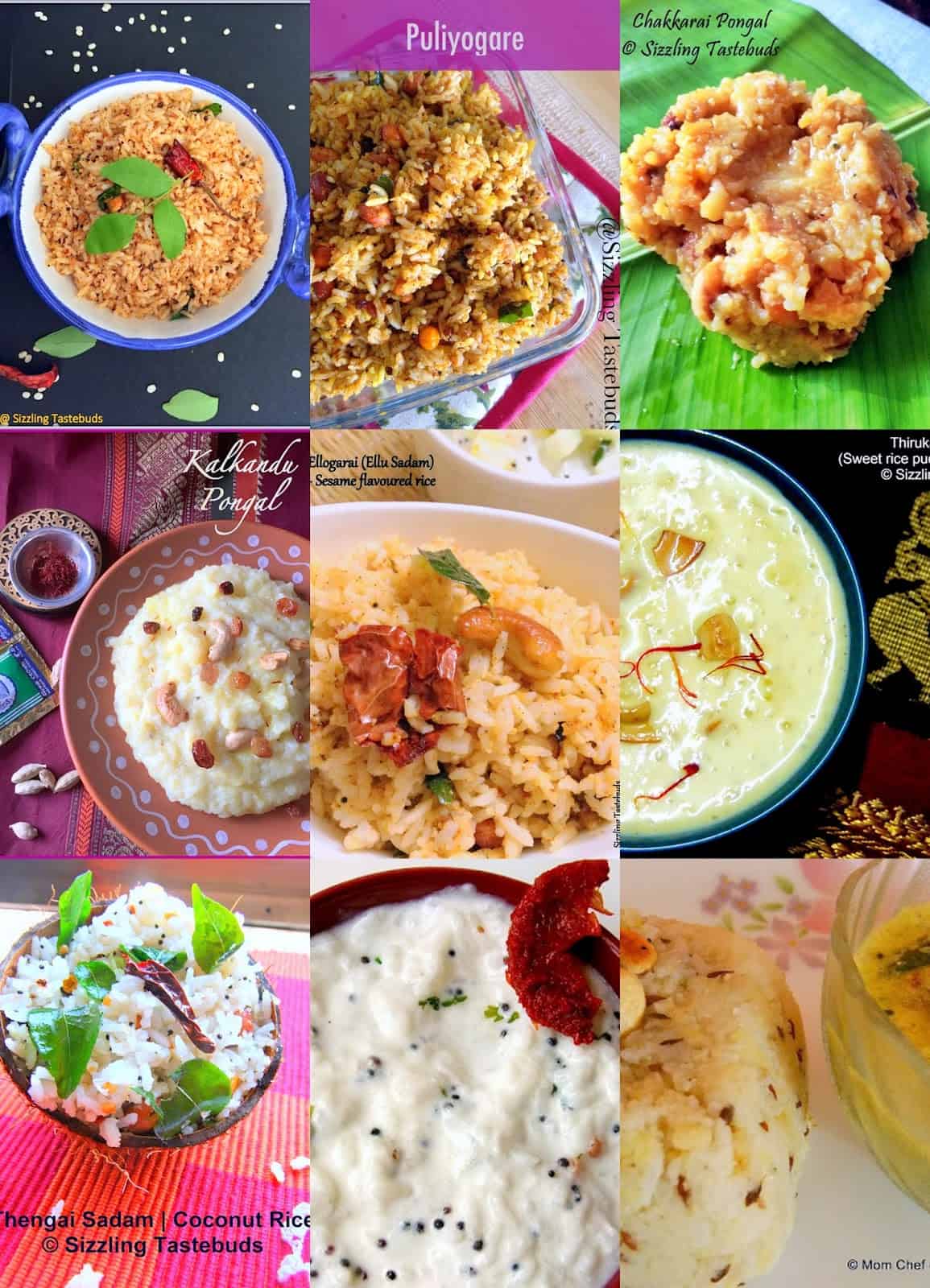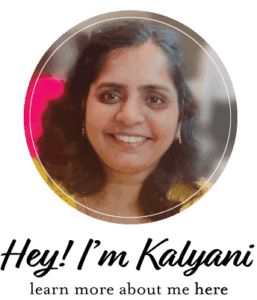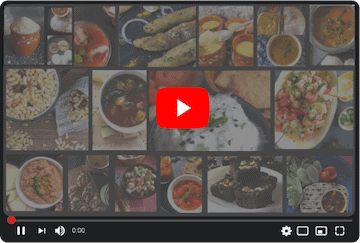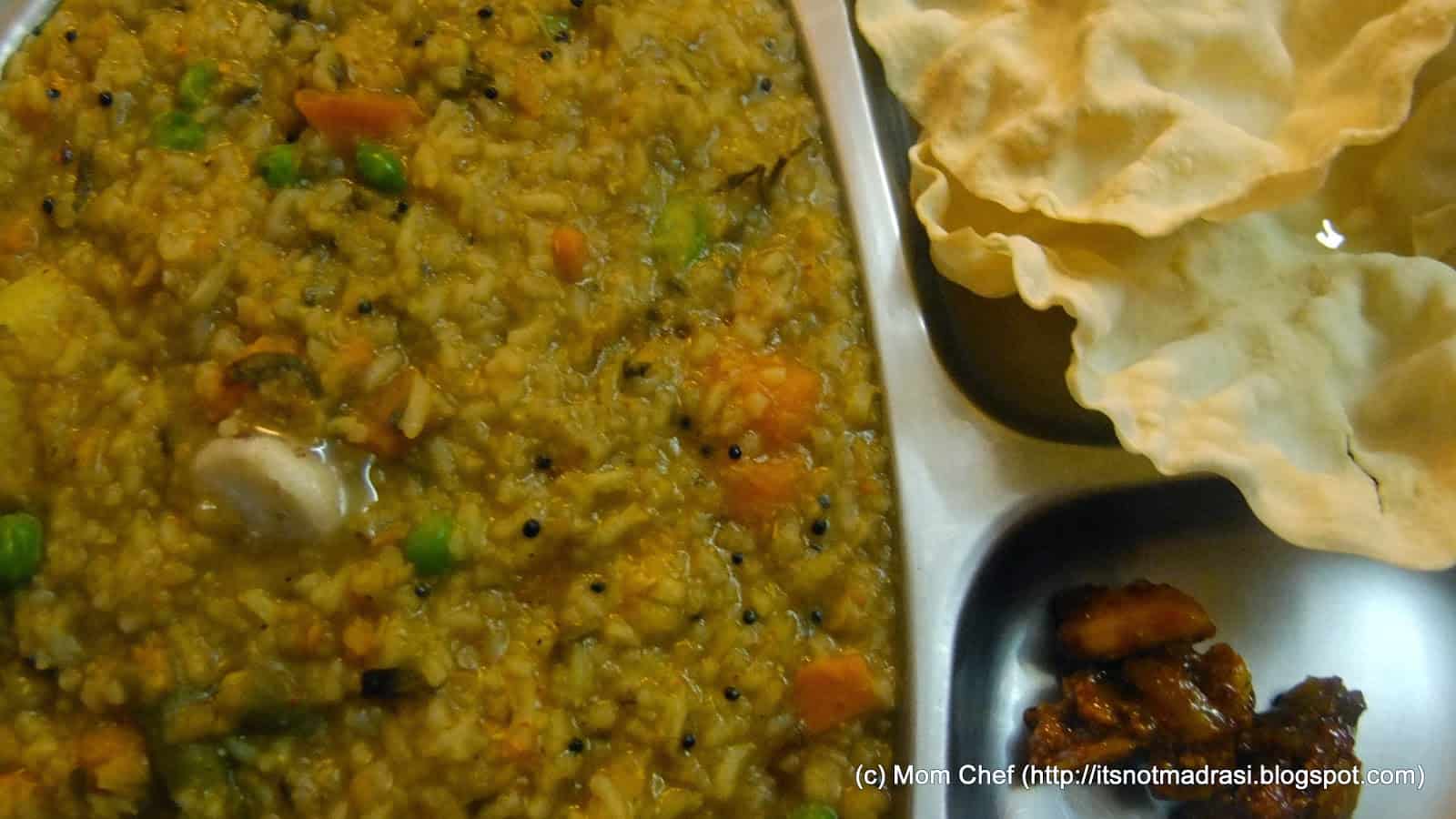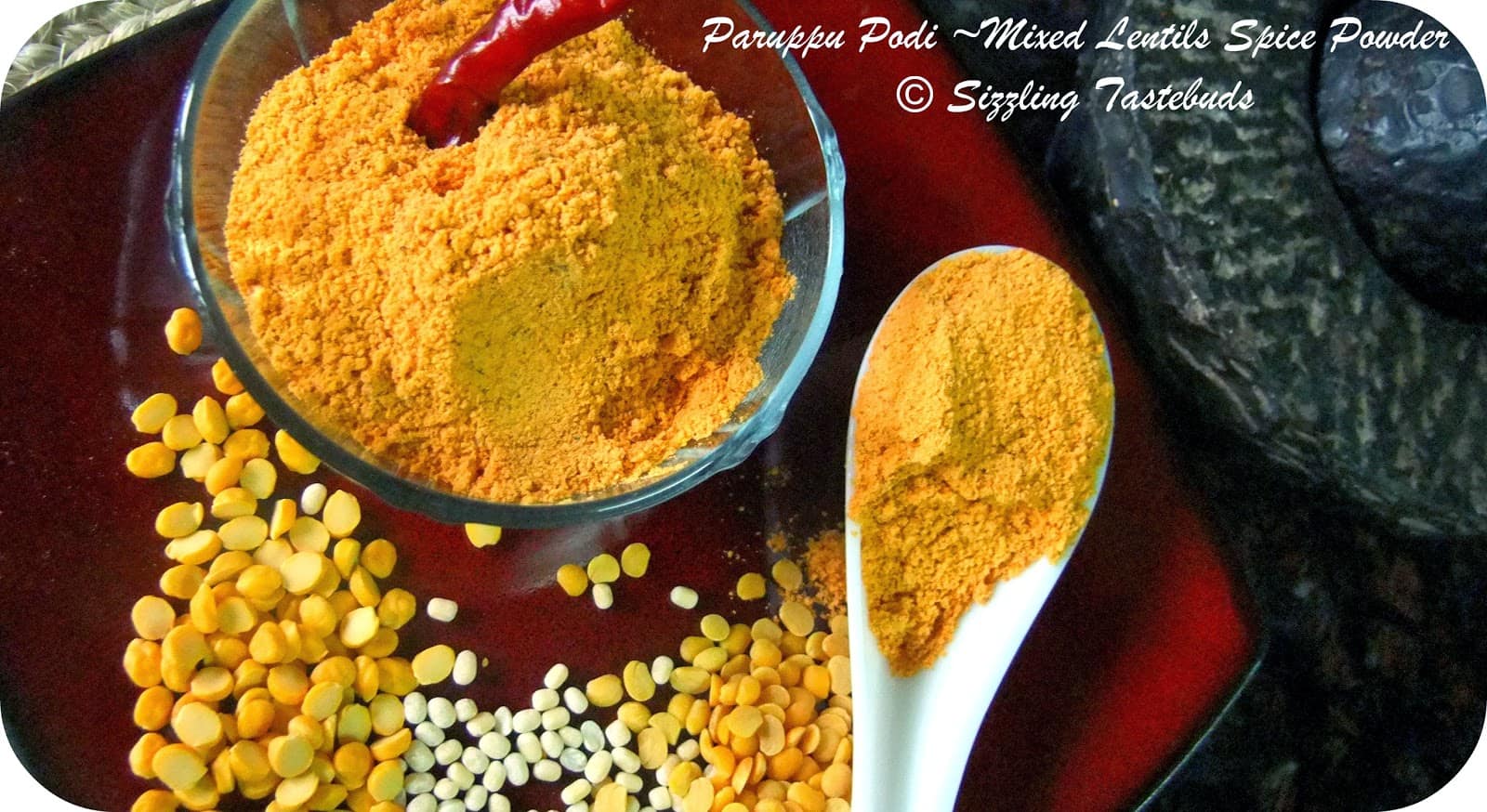A One-stop collection of Navratri Prasadam covering all Prasadam or Naivedyam offerings made during the festive season.
The Sharad Navaratri (or Autumnal holy 9 days of the Hindu Calendar) begins shortly. Happy Dusshera / Navratri to all my readers…
Devi (or the Goddess) is worshipped in 9 forms in North India as Maa Shailputri, Maa Brahmacharini, Maa Chandraghanta, Maa Kushmanda, Maa Katyayani, Maa Kalratri, Maa Siddhidatri, Maa Skandmata, Maa Mahagauri .
Navratri is celebrated across India with variations in customs and traditions based on regional and cultural differences. Here’s a brief overview of how Navratri is celebrated in different regions of India:
- Gujarat: Navratri is one of the most widely celebrated festivals in Gujarat. People participate in Garba and Dandiya Raas dances, which involve dancing in circular formations with sticks. The entire state comes alive with colorful and vibrant festivities.
- West Bengal: Navratri is celebrated as Durga Puja, one of the biggest festivals in West Bengal. Elaborate decorations and idols of Goddess Durga are displayed in pandals (temporary structures). The festival concludes with the immersion of the idols in rivers or water bodies.
- North India: In states like Punjab and Haryana, Navratri is marked by the celebration of Durga Puja, fasting, and elaborate prayers. In some regions, Ramlila performances narrating the story of Lord Rama are organized, culminating with the burning of effigies of Ravana on Dussehra.
- Kolkata: In Kolkata, Durga Puja during Navratri is a grand affair. Lavish decorations, artistic idols, cultural performances, and processions are a significant part of the celebration.
- Maharashtra: Navratri is celebrated with devotion and fasting. In some areas, people install idols of Goddess Durga in their homes. The festival concludes with the immersion of these idols in water bodies on the tenth day, known as Dashami.
- South India: In states like Karnataka, Andhra Pradesh, and Tamil Nadu, Navratri is observed with prayers, music, and dance. The display of dolls and figurines on steps (Golu/Kolu) is a common tradition, and traditional sweets and dishes are prepared.
- Eastern India: In states like Odisha, Navratri is marked by the worship of Goddess Durga and fasting. Cultural events and processions are organized, and the festival concludes with the immersion of idols.
- Rajasthan: Navratri is celebrated with traditional folk dances like Ghoomar and Gauri dance. Women and men dress in vibrant attire, and the festival is marked by the worship of Goddess Durga.
- Kerala: In Kerala, Navratri is observed as Saraswati Puja. Children are initiated into writing and reading on this day, and books and musical instruments are placed for blessings in front of the goddess Saraswati.
- Jammu and Kashmir: In the northernmost region of India, Navratri is celebrated with fasting and prayers. It is a time for religious observances and devotion to the goddess Durga.
These regional variations reflect the diversity of India’s culture and traditions, but the common theme across all regions is the celebration of the divine feminine energy during Navratri.
Whereas in the South, the Goddess is worshipped as Durga,Kali,Amba or Jagadamba, Annapoornadevi, Sarvamangala, Bhairavi,Chandika or Chandi, Lalitha, Bhavani,Mookambika or Tara on the 9 days respectively.

The final day is called Vijayadashami or Bijoyadashami or Dusherra (depending on where one stays) which marks the culminating day of the 9 day festival and a festive grand lunch follows the elaborate pooja that’s performed on this day. Its also a very very auspicious day in Hindu system to start new ventures like Vidyarambham (first initiation into learning), or buy a new home or car etc.
For more ideas on mini thalis, click here, here,here & here
Golu or dolls in 3-5-7-9 steps are neatly arranged in South Indian homes, often with a theme to go with, and there is a social – cultural event happening inviting ladies for Haldi Kumkum to each others’ places in the evening times.

Navratri is also known for the conquer of good over evil and is celebrated as Dusshera. Its the time when Lord Ram returned to Ayodhya after vanquishing the demon Ravan. An effigy of the demon is burnt on the last day to symbolise the same
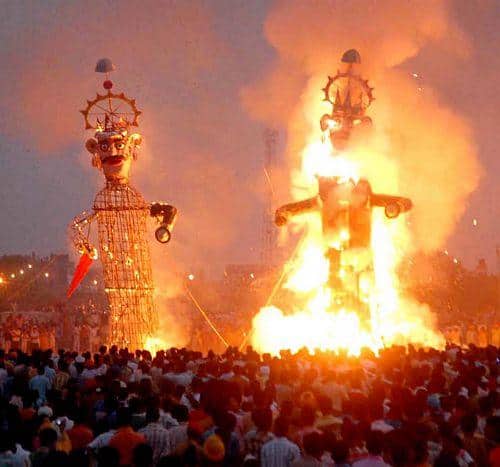 |
| Pic courtesy : here |
Durga Puja (or Pujo as its called), is a major festival in Kolkata, West Bengal and eastern parts of India. Elaborate pandals like the ones below are erected and the Goddess is worshipped with pomp and grandeur. Pandal hopping is considered a must-do during this season.
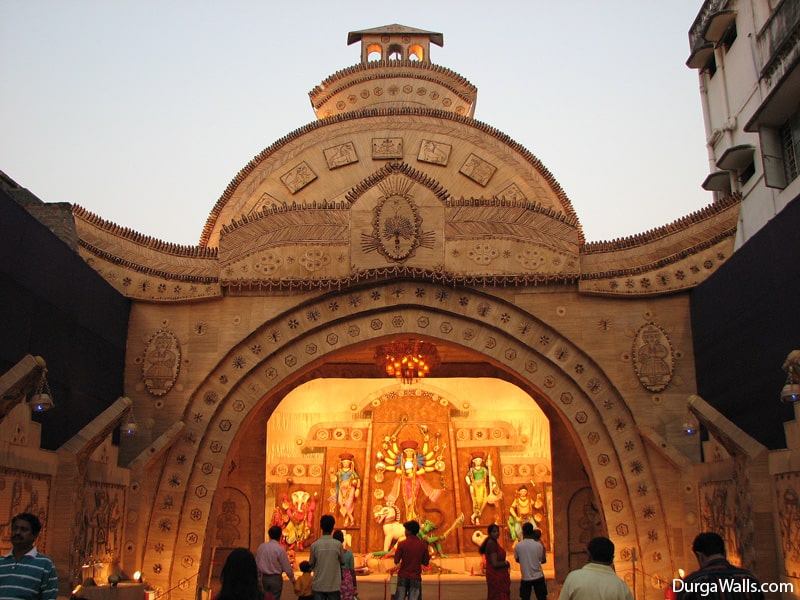 |
| Pic Courtesy : here |
In Gujarat, Dandiya / Garbha is a social must-do where women and men deck up in their finery and dance thru the night as a form of social & cultural mingling, coupled with mind blowing feasts to the eye and the palate 🙂

Many people fast religiously, and although as a family we don’t fast, we abstain from using certain tamasic causing ingredients in our cooking like onion, garlic, brinjal, cabbage etc). Most North Indian families prohibit cooking of even potatoes,sodium based salt , Wholewheat atta, and stick to what they believe in – like cooking with more starch based ingredients like Sabudana (tapoica pearls), sweet potato, rajgira flour (amaranth flour), sama or vrat ke chawal.
Whatever the form, whatever the God /Goddess being worshipped or whatever belief one follows wrt food and local practices, these 9 days of Navaratri (Nava = 9, rathri = night) are sacred for Hindus across the world.
Some of the offerings (Naivedyam) that can be prepared for Navratri are….Happy festive season :))
9 varieties Sundals (steamed based lentil snack – vegan & gluten free). These sundals can also be made with steamed legumes topped with Sundal Podi
(from top left top row to bottom right last row, links as follows):
- Kadalai Paruppu Sundal ~ Kadalebele Usli
- Konda Kadalai Sundal ~ Black Channa Sundal
- Masoor Dal Sundal | Whole Red Lentil Salad
- Payiru Sundal ~ Green gram steamed stir fry ~ Moong Dal Sundal
- Avarekaalu Usli | Hyacinth bean Salad
- Battani Sundal | Fresh Peas Sundal
- Kabuli Channa Sundal
- Sprouts Sundal
- Fresh Rajma Sundal
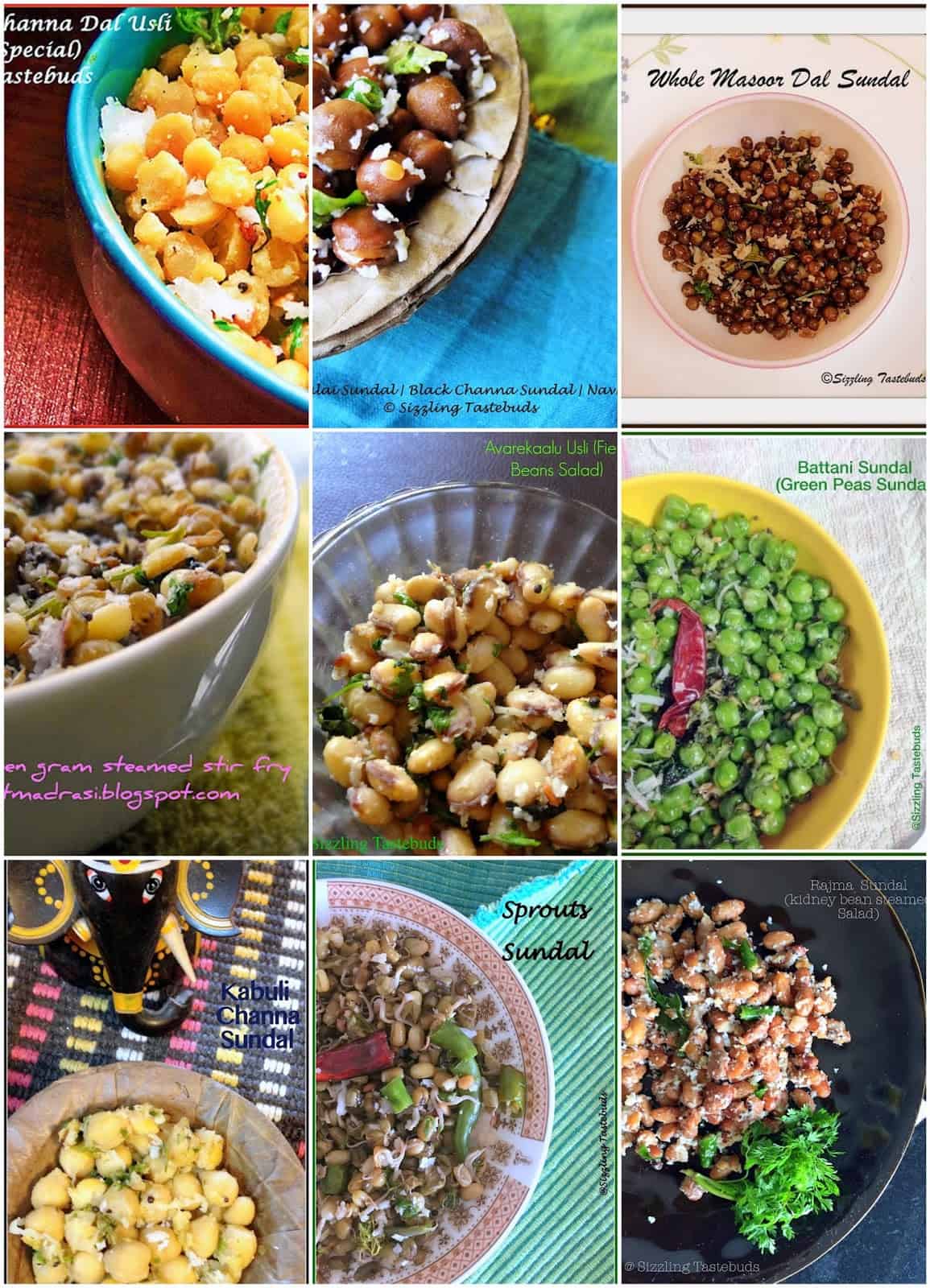
9 varieties of Kheer / Payasam & milk based sweets for Offering
again, in order from top left (1st row onwards), recipes are:
- Badam Sevai Payasam | Almond and vermicelli Kheer or Pudding
- Javvarisi Carrot Payasam | Sago-Carrot Pudding
- Gasagase Payasa | Poppy Seeds Kheer | Khus Khus Kheer
- Sabbakki Payasa | Javvarisi Payasam | Sago Pearls Kheer
- Arisi Kesari Pal Payasam | Saffron based milk pudding
- Kadalai Paruppu Payasam | Channa Dal Kheer
- Semiya Payasam ~ Vermicilli Kheer
- Akkaravadisal
- Pal Payasam
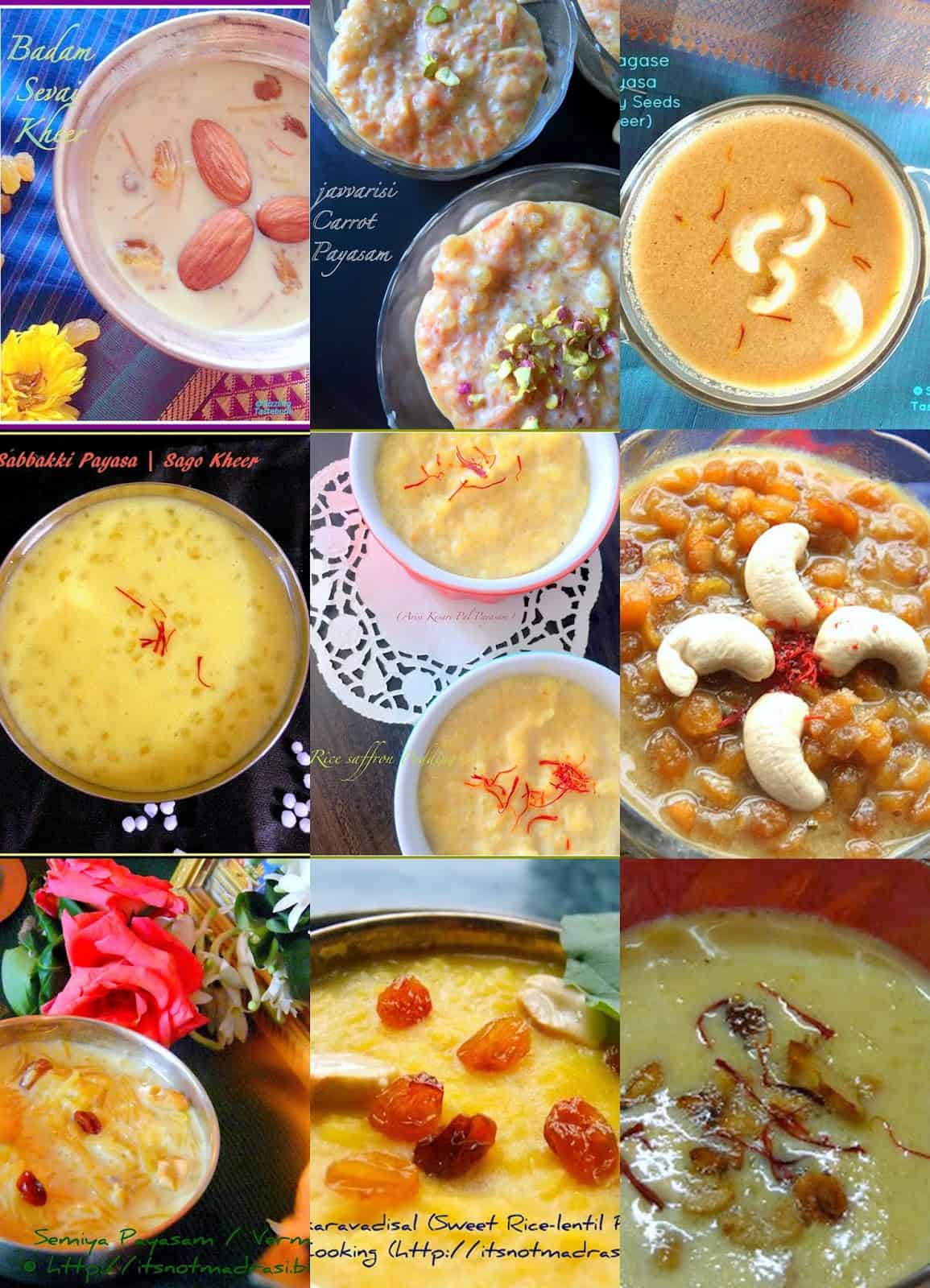
9 Flavoured Rice varieties (without any onion – garlic or tamasic ingredients)
- Ulundogarai (Urad dal flavoured spice rice)
- Puliyodhorai (tamarind rice)
- Chakkarai Pongal (sweet pongal made with rice + jaggery)
- Kalkandu Pongal (candy sugar based sweet pongal)
- Ellogarai (sesame flavoured rice)
- Thiru Kannamudhu (sweet rice pudding)
- Thengai Saadam (coconut flavoured rice)
- Dudhyodhanam (tempered curd rice)
- Ven Pongal (savoury Pongal)
